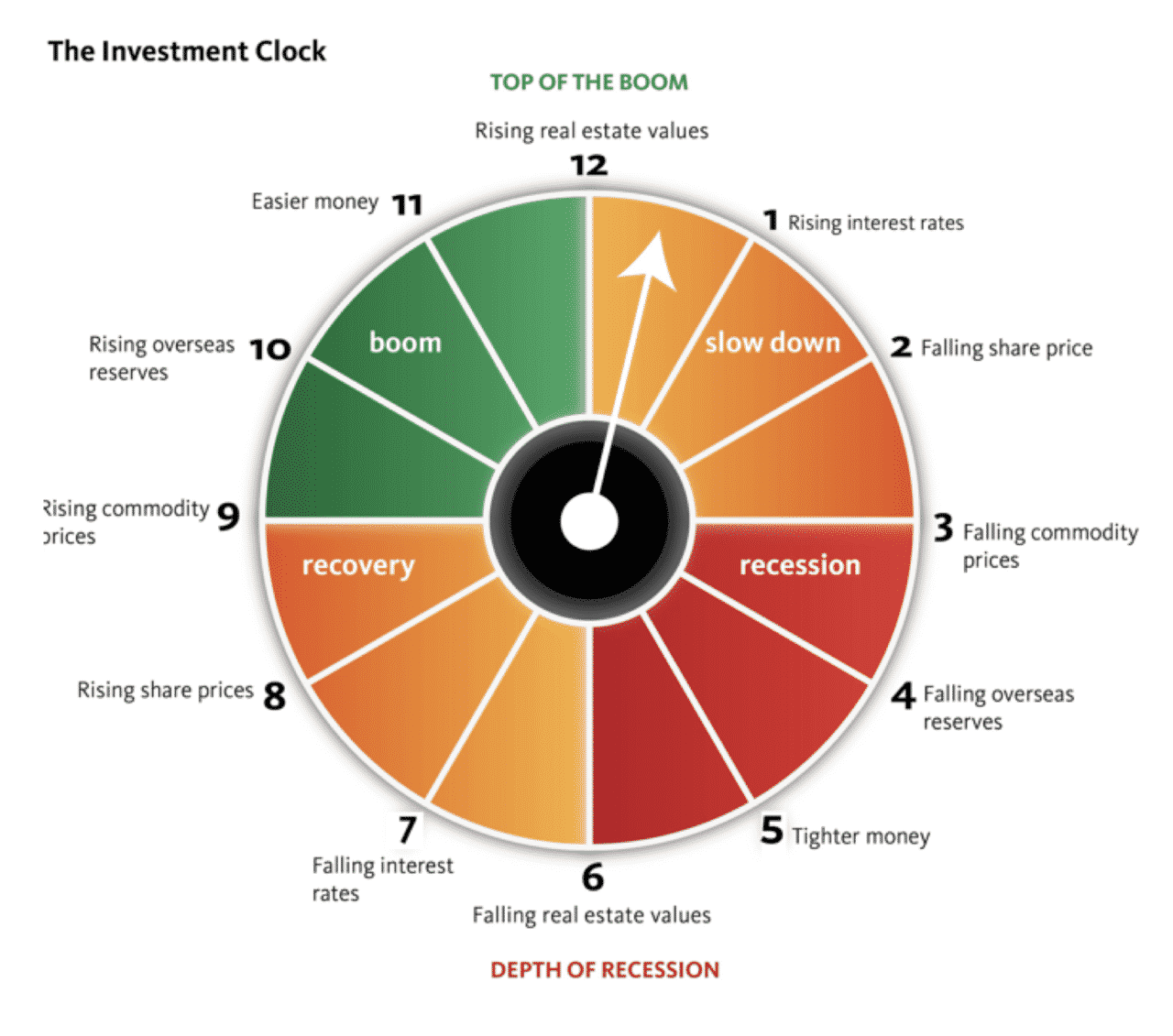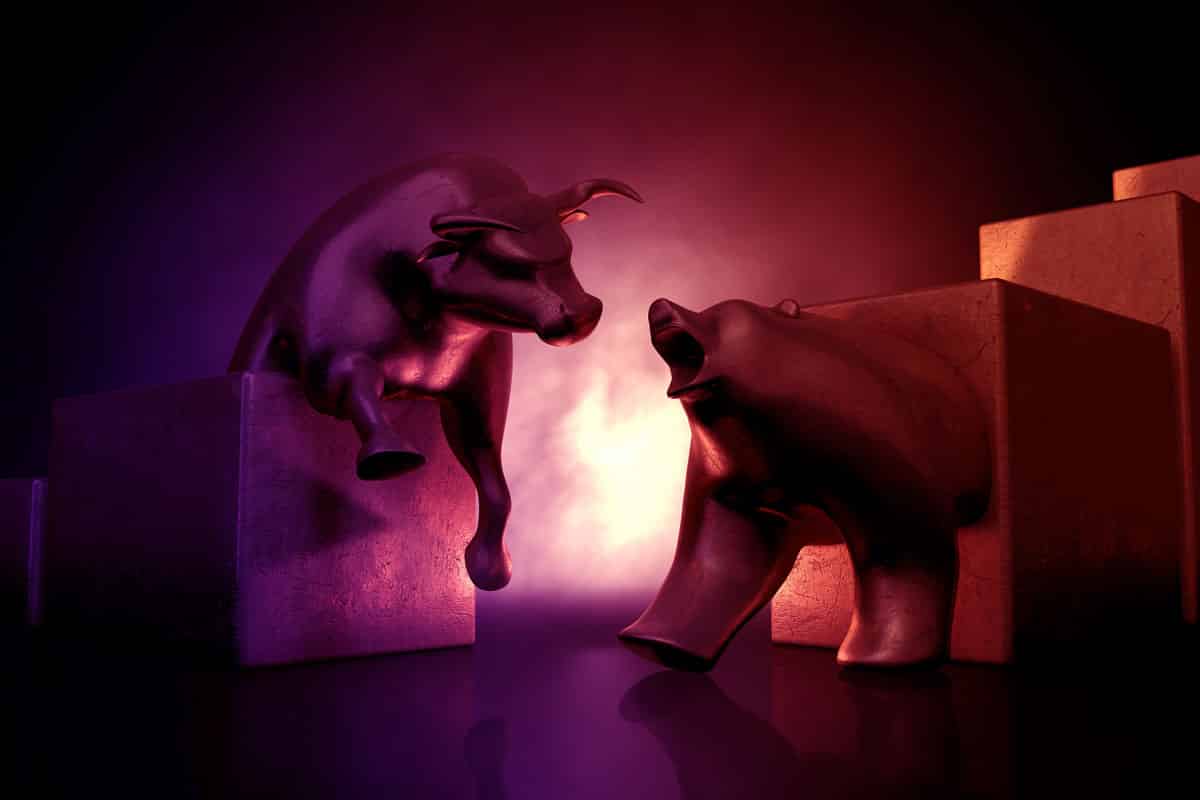DEFINING BULL versus BEAR MARKETS
What is the difference between a Bull and a Bear market, and what to look out for!
“The farther back you can look, the farther forward you are likely to see.”
Winston Churchill
History tells us that investments can go down as well as up. It’s a well-worn, renowned disclaimer designed to provide a caution to all; they don’t always go the way you want them to. Less well known is the pattern the financial markets have followed throughout history. In the financial world, this pattern is referred to as Bull and Bear Markets.
It may be too obvious to explain that Bull follows Bear, and Bear follows Bull, but perhaps slightly less obvious is that there are four stages to the pattern. Growth and Peak; representative of a Bull market and Contraction and Trough; representative of a Bear market.

A significant feature of the pattern is that the ‘Growth’ period is almost always slow and long. The contraction period is, more often than not, alarmingly quick, like falling off a cliff straight from Peak and Trough. Interestingly, the recovery period between Trough and Peak tends to be a complete reverse, taking an agonisingly slow time to climb back up, therefore historically taking a long time to recover from losses.
Below we’ve pulled together a short guide to help explain the terminology.
Bull Market
01.
What is a Bull Market?
- The expression ‘Bull Market’ describes a market that is on the rise.
- This term is often related to the stock market, however can be applied to anything traded; bonds, real estate and currencies for example.
- The rise and fall of these market prices are normally constant, so the term “Bull Market’ is normally saved for the extended periods of time when a big portion of the prices are rising.
- Typically, a market is defined as a bull market when its value has risen 20% from a 52-week high.
- Sometimes a steep rise or fall in market prices can simply be a market correction rather than a defined type of market. A rise of 10-20% is considered a market correction, with one higher than 20% considered a bull market.
04.
What are the risks in a Bull Market?
- Although hard to distinguish when the ‘Growth and Peak’ of the market will be, most losses will be small and only temporary. Normally, investors can confidently invest in equities with a high probability of making a return.
02.
What causes a Bull Market?
- A Bull Market occurs when the economy is doing well; levels of unemployment are low, Gross Domestic Product (GDP) is high, and stocks are consistently rising.
- There is often strong share demand and low share supply during this time. This is because as the interest in the markets increases, so do share prices. In other words, many investors are wishing to buy, while few are willing to sell.
03.
What are sensible moves to make in a Bull Market?
- The ideal thing for an investor to do in a Bull Market is take advantage of the rising prices. They can do this by buying at a low trough, just as the market begins to grow, and then selling at a high peak, just before it drops back down.Unfortunately, there is no specific metric to identify any peaks or troughs. They are hard to predict, so knowing the right time to do this accurately is tricky.
01.
What is a Bull Market?
- The expression ‘Bull Market’ describes a market that is on the rise.
- This term is often related to the stock market, however can be applied to anything traded; bonds, real estate and currencies for example.
- The rise and fall of these market prices are normally constant, so the term “Bull Market’ is normally saved for the extended periods of time when a big portion of the prices are rising.
- Typically, a market is defined as a bull market when its value has risen 20% from a 52-week high.
- Sometimes a steep rise or fall in market prices can simply be a market correction rather than a defined type of market. A rise of 10-20% is considered a market correction, with one higher than 20% considered a bull market.
02.
What causes a Bull Market?
- A Bull Market occurs when the economy is doing well; levels of unemployment are low, Gross Domestic Product (GDP) is high, and stocks are consistently rising.
- There is often strong share demand and low share supply during this time. This is because as the interest in the markets increases, so do share prices. In other words, many investors are wishing to buy, while few are willing to sell.
03.
What are sensible moves to make in a Bull Market?
- The ideal thing for an investor to do in a Bull Market is take advantage of the rising prices. They can do this by buying at a low trough, just as the market begins to grow, and then selling at a high peak, just before it drops back down.Unfortunately, there is no specific metric to identify any peaks or troughs. They are hard to predict, so knowing the right time to do this accurately is tricky.
04.
What are the risks in a Bull Market?
- Although hard to distinguish when the ‘Growth and Peak’ of the market will be, most losses will be small and only temporary. Normally, investors can confidently invest in equities with a high probability of making a return.
Bear Market
01.
What is a Bear Market?
- The flip side of a Bull Market is a Bear Market. This refers to a market in decline; where share prices have dropped, there is a downward trend in the economy and unemployment is high.
- The length of a Bear Market is often far shorter than a Bull Market, only lasting an average of two to three years as opposed to six to seven years for a Bull market, however the loss within this time period is much greater.
- Typically, a market is defined as a bear market when its value has fallen 20% from a 52-week high.
- Sometimes a steep rise or fall in market prices can simply be a market correction rather than a defined type of market. A fall of 10-20% is considered a market correction, with 20% or more considered a bear market.
04.
What are the risks in a Bear Market?
- Chances of losses are much greater in a Bear Market as prices are continually losing value.
- Even if you do invest in the hope of an upturn, you are more than likely to lose out before any turnaround happens.
02.
What causes a Bear Market?
- Often, it is a weak, slow economy that brings around a Bear Market, but any intervention from the government can also be a trigger, e.g any change in the tax rate can lead to the market declining.
- Any decline in stock market prices shakes investor confidence, often forcing them to take their money out of the market. This in turn, causes the decline in the stock market.
03.
What are sensible moves to make in a Bear Market?
- In a bear market, the chances of loss are greater because prices are continually losing value. Investors are better off “short selling” or making safer investments, such as fixed-income securities.
- An investor could turn to defensive stocks. These are often only minimally affected by changing market trends and are therefore more stable in an economic slump.

This chart shows the pattern that US and UK stocks have both followed over the last 80+ years. It demonstrates that Bull Markets tend to last an average of 6-7 years, with a cumulative average return of over 200%. Conversely, Bear Markets often last less than 2-3 years, but with a potential loss of nearly 50%.
What to look out for

There have been numerous Bull and Bear Market cycles since 1929, with the economic recession in 2008 being the last Bear Market etched in our memories. It delivered a cumulative “Contraction and Trough” fall of -41% and started less than five years after the previous Bear Market in the late 90’s, which at the time, abruptly curtailed 12 years of prosperity with a similar cumulative fall of -43%.
In the current Bull Market, as we start enjoying our tenth year of continued growth, there is undoubtedly an abundance of economic uncertainty. However, if there is one thing we can deduce from the past, it is not to fight with bears, rather take the growth we have enjoyed over the last nine years and find a way to PROTECT IT!.





Heya i’m for the first time here. I found this board and I find It really
useful & it helped me out much. I hope to give something back and aid others like you helped me.
There are some interesting cut-off dates in this article but I don抰 know if I see all of them middle to heart. There may be some validity however I will take hold opinion until I look into it further. Good article , thanks and we wish more! Added to FeedBurner as nicely
Does anybody know whether The Vape Shoppe ecigarette store located in 46874 Romeo Plank Road offers e-juice manufactured by Bodyrock? I have emailed them at vapor4me@gmail.com
Hey there! I could have sworn I’ve been to this site before but after browsing through some of the post I realized it’s new to me. Anyways, I’m definitely glad I found it and I’ll be book-marking and checking back frequently!
I have observed that over the course of constructing a relationship with real estate owners, you’ll be able to come to understand that, in most real estate exchange, a commission rate is paid. In the long run, FSBO sellers will not “save” the fee. Rather, they struggle to win the commission by doing a agent’s work. In the process, they expend their money in addition to time to carry out, as best they’re able to, the jobs of an realtor. Those jobs include exposing the home by means of marketing, presenting the home to willing buyers, developing a sense of buyer emergency in order to induce an offer, making arrangement for home inspections, managing qualification checks with the mortgage lender, supervising maintenance tasks, and aiding the closing of the deal.
Wonderful blog! I found it while searching on Yahoo News. Do you have any tips on how to get listed in Yahoo News? I’ve been trying for a while but I never seem to get there! Many thanks
Thank you a lot for sharing this with all folks you really realize what you’re talking approximately! Bookmarked. Kindly additionally visit my web site =). We could have a link exchange arrangement among us!
Big Comparison Is Here: Fake Rolex VS Real
The most popular watch models of luxury watch brands are sold at very
high prices. As such, many people are turning to affordable watch
alternatives of luxury watch brands. At this point, a confusion arises.
Replica and fake watch confusion … In this article,
we will touch on fake Rolex VS real and discuss the curious details.
You can learn the difference between these two types of watches by reading our article.
jf factory
One thing is the fact that one of the most popular incentives for utilizing your card is a cash-back or perhaps rebate provision. Generally, you’re going to get 1-5 back for various purchases. Depending on the credit cards, you may get 1 back on most purchases, and 5 again on expenses made from convenience stores, filling stations, grocery stores in addition to ‘member merchants’.
Big Comparison Is Here: Fake Rolex VS Real
The most popular watch models of luxury watch brands are sold at very high prices.
As such, many people are turning to affordable watch alternatives of luxury watch brands.
At this point, a confusion arises. Replica and fake
watch confusion … In this article, we will touch on fake
Rolex VS real and discuss the curious details. You can learn the difference between these two types of watches
by reading our article. jf factory
can i use cartridges withe vape juice
can i take a vape on a plane 2017
Big Comparison Is Here: Fake Rolex VS Real
The most popular watch models of luxury watch brands are sold at very high prices.
As such, many people are turning to affordable watch alternatives of luxury watch brands.
At this point, a confusion arises. Replica and fake watch confusion … In this article, we will touch on fake Rolex VS real and discuss the curious details.
You can learn the difference between these two types of watches by reading our article.
jf factory
Keep on writing, great job!
I discovered more new things on this weight-loss issue. Just one issue is that good nutrition is tremendously vital when dieting. A huge reduction in bad foods, sugary ingredients, fried foods, sugary foods, red meat, and white-colored flour products may be necessary. Keeping wastes organisms, and harmful toxins may prevent desired goals for losing fat. While a number of drugs temporarily solve the situation, the unpleasant side effects usually are not worth it, they usually never supply more than a non permanent solution. It’s a known proven fact that 95 of dietary fads fail. Thank you for sharing your notions on this weblog.
Hello, I wish for to subscribe for this webpage to obtain newest updates, therefore where can i do it please help out.
Hey! Would you mind if I share your blog with my zynga group? There’s a lot of people that I think would really appreciate your content. Please let me know. Thank you
Thanks for the suggestions shared on the blog. Yet another thing I would like to say is that losing weight is not about going on a fad diet and trying to reduce as much weight as you can in a couple of weeks. The most effective way to shed weight is by getting it slowly and gradually and using some basic suggestions which can make it easier to make the most from your attempt to shed pounds. You may realize and already be following many of these tips, although reinforcing awareness never does any damage.
I pay a quick visit day-to-day a few blogs and information sites to read articles or reviews, however this blog provides feature based posts.
Big Comparison Is Here: Fake Rolex VS Real
The most popular watch models of luxury watch brands are sold at very high prices.
As such, many people are turning to affordable watch alternatives of luxury
watch brands. At this point, a confusion arises.
Replica and fake watch confusion … In this article,
we will touch on fake Rolex VS real and discuss the curious details.
You can learn the difference between these two types of watches by reading our article.
jf factory
Thanks for the concepts you are giving on this blog. Another thing I would really like to say is that getting hold of some copies of your credit score in order to scrutinize accuracy of the detail could be the first motion you have to perform in fixing credit. You are looking to clear your credit reports from damaging details problems that damage your credit score.
Pretty nice post. I just stumbled upon your blog and wished to say that I’ve truly enjoyed browsing your blog posts. After all I will be subscribing to your rss feed and I hope you write again soon!
I together with my guys appeared to be checking the good information and facts on your web page and then suddenly I got a terrible suspicion I never thanked the site owner for those strategies. These young men ended up so joyful to read through all of them and already have quite simply been loving them. Thank you for turning out to be well considerate as well as for getting varieties of useful subject matter most people are really eager to be informed on. My very own sincere apologies for not saying thanks to sooner.
Thanks for your submission. I would love to comment that the very first thing you will need to complete is verify if you really need credit improvement. To do that you have got to get your hands on a copy of your credit score. That should not be difficult, because the government mandates that you are allowed to have one totally free copy of your real credit report annually. You just have to request the right individuals. You can either browse the website for your Federal Trade Commission and also contact one of the major credit agencies instantly.
Undeniably believe that which you said. Your
favorite reason seemed to be on the web the easiest thing to be aware of.
I say to you, I definitely get annoyed while people think about
worries that they just don’t know about. You managed to hit the nail upon the top as well as defined
out the whole thing without having side effect , people can take a signal.
Will probably be back to get more. Thanks
If you want to increase your experience just keep visiting this site and be updated with the
hottest news update posted here.
I do agree with all of the ideas you have presented to your post.
They are very convincing and can definitely work. Nonetheless, the
posts are too quick for newbies. Could you please extend them a bit from next time?
Thank you for the post.
Is anyone here in a position to recommend Sexy Nightwear? Thanks xx
It is indeed my belief that mesothelioma is most lethal cancer. It’s got unusual traits. The more I look at it a lot more I am certain it does not behave like a real solid human cancer. In case mesothelioma is often a rogue virus-like infection, in that case there is the chance of developing a vaccine as well as offering vaccination for asbestos open people who are really at high risk regarding developing long term asbestos relevant malignancies. Thanks for expressing your ideas for this important ailment.
I抳e been exploring for a bit for any high-quality articles or blog posts in this sort of area . Exploring in Yahoo I eventually stumbled upon this site. Reading this information So i am satisfied to convey that I’ve an incredibly excellent uncanny feeling I came upon exactly what I needed. I such a lot surely will make sure to don抰 fail to remember this web site and give it a look on a constant basis.